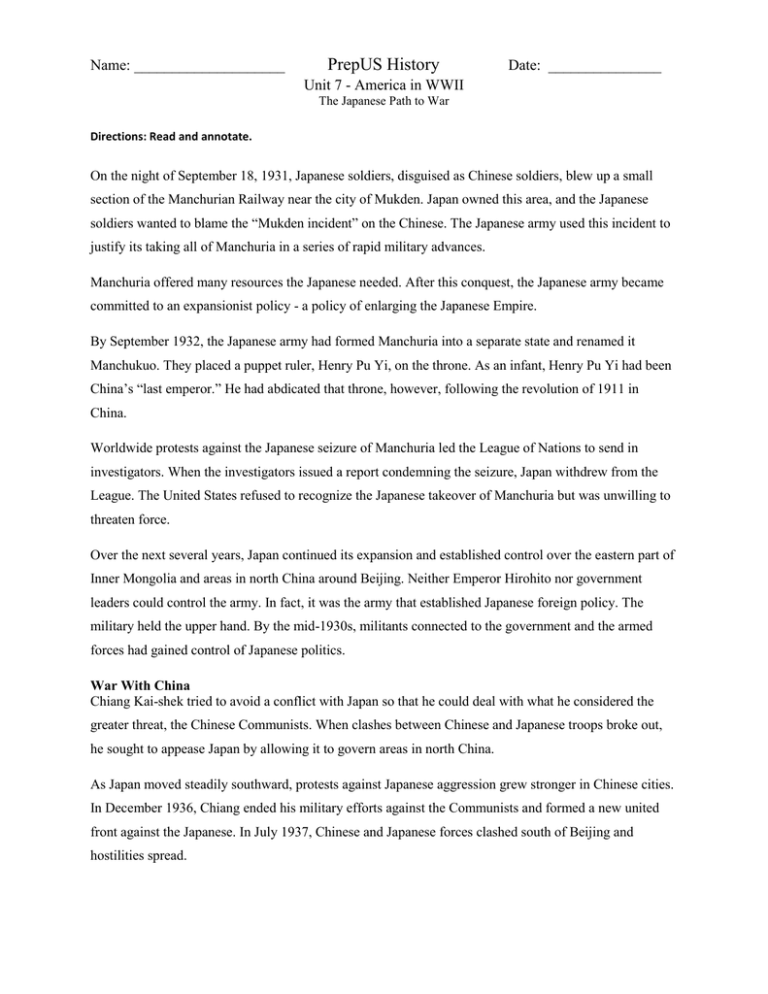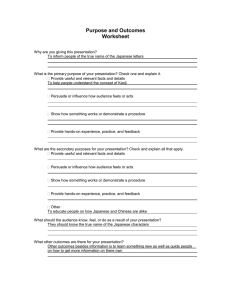PrepUS History Name: ____________________ Date: _______________
advertisement

Name: ____________________ PrepUS History Date: _______________ Unit 7 - America in WWII The Japanese Path to War Directions: Read and annotate. On the night of September 18, 1931, Japanese soldiers, disguised as Chinese soldiers, blew up a small section of the Manchurian Railway near the city of Mukden. Japan owned this area, and the Japanese soldiers wanted to blame the “Mukden incident” on the Chinese. The Japanese army used this incident to justify its taking all of Manchuria in a series of rapid military advances. Manchuria offered many resources the Japanese needed. After this conquest, the Japanese army became committed to an expansionist policy - a policy of enlarging the Japanese Empire. By September 1932, the Japanese army had formed Manchuria into a separate state and renamed it Manchukuo. They placed a puppet ruler, Henry Pu Yi, on the throne. As an infant, Henry Pu Yi had been China’s “last emperor.” He had abdicated that throne, however, following the revolution of 1911 in China. Worldwide protests against the Japanese seizure of Manchuria led the League of Nations to send in investigators. When the investigators issued a report condemning the seizure, Japan withdrew from the League. The United States refused to recognize the Japanese takeover of Manchuria but was unwilling to threaten force. Over the next several years, Japan continued its expansion and established control over the eastern part of Inner Mongolia and areas in north China around Beijing. Neither Emperor Hirohito nor government leaders could control the army. In fact, it was the army that established Japanese foreign policy. The military held the upper hand. By the mid-1930s, militants connected to the government and the armed forces had gained control of Japanese politics. War With China Chiang Kai-shek tried to avoid a conflict with Japan so that he could deal with what he considered the greater threat, the Chinese Communists. When clashes between Chinese and Japanese troops broke out, he sought to appease Japan by allowing it to govern areas in north China. As Japan moved steadily southward, protests against Japanese aggression grew stronger in Chinese cities. In December 1936, Chiang ended his military efforts against the Communists and formed a new united front against the Japanese. In July 1937, Chinese and Japanese forces clashed south of Beijing and hostilities spread. Although Japan had not planned to declare war on China, the 1937 incident turned into a major conflict. Japan seized the Chinese capital of Nanjing in December. The Japanese Army destroyed the city and massacred more than 100,000 civilians and prisoners of war. The event was so brutal it became known as the “Rape of Nanjing.” Chiang Kai-shek refused to surrender and moved his government upriver, first to Hankou, then to Chongqing. Temporarily defeated, the Chinese continued to resist. The New Asian Order Japanese military leaders had hoped to force Chiang to agree to join a New Order in East Asia, comprising Japan, Manchuria, and China. Japan would attempt to establish a new system of control in Asia with Japan guiding its Asian neighbors to prosperity. Part of Japan’s plan was to seize Soviet Siberia, with its rich resources. During the late 1930s, Japan began to cooperate with Nazi Germany. Japan assumed that the two countries would ultimately launch a joint attack on the Soviet Union and divide Soviet resources between them. When Germany signed the nonaggression pact with the Soviets in August 1939, Japanese leaders had to rethink their goals. Because Japan lacked the resources to defeat the Soviet Union, it looked to South Asia for raw materials for its military machine. Japan Launches Attack A move southward would risk war with the European powers and the United States. Japan’s attack on China had already aroused strong criticism, especially in the United States. Still, in the summer of 1940, Japan demanded the right to exploit economic resources in French Indochina. The United States objected. It warned Japan that it would apply economic sanctions unless Japan withdrew from the area and returned to its borders of 1931. Japan badly needed the oil and scrap iron it was getting from the United States. Should these resources be cut off, Japan would have to find them elsewhere. This would threaten Japan’s long-term objectives. Japan was now caught in a dilemma. To guarantee access to raw materials in Southeast Asia, Japan had to risk losing them from the United States. After much debate, Japan decided to launch a surprise attack on U.S. and European colonies in Southeast Asia. 2


